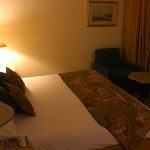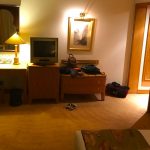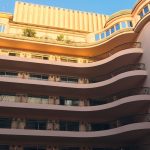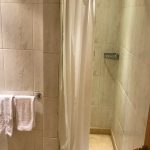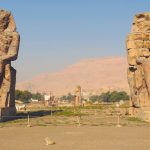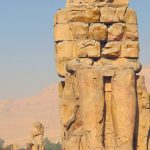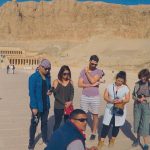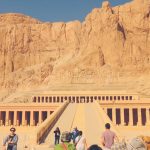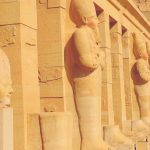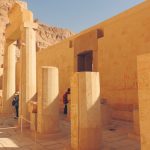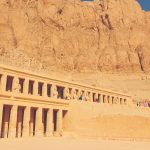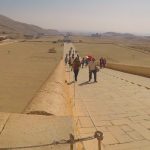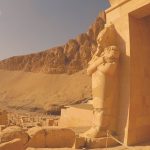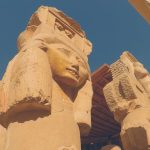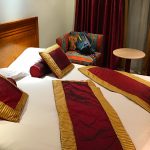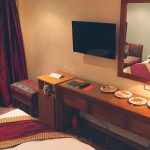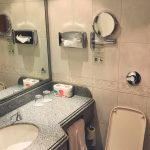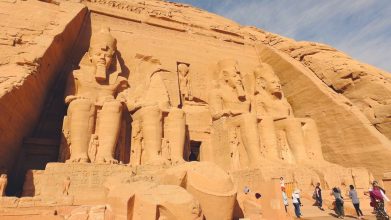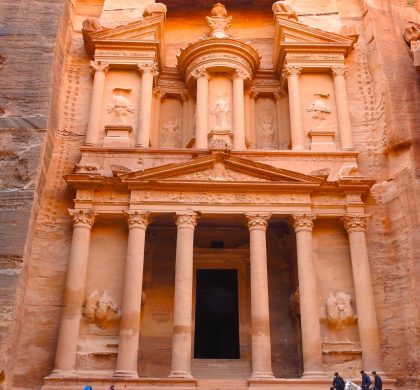Luxor & Aswan Highlights & Recap
This morning day three of the Travel Talk Tours Egypt & Jordan Discovered Tour begins from Luxor where the tour arrived last night for a brief overnight stay. Before arriving in Luxor the tour has already taken in some amazing sites with the journey beginning in the capital city of Egypt, Cairo two days ago. This is where the tour group met for the first time and while in Cairo day two of the tour included a full day of sightseeing as well as taking in the the last remaining ancient seventh wonder of the world, the Great Pyramids of Giza. A visit was also made to the famous Step Pyramid of Djoser in Sakkara before arriving at Luxor for the evening after a long drive.
RECAP: Cairo & the Great Pyramids of Giza to Luxor – Day 01 & 02 Travel Talk Egypt & Jordan Discovered Tour
As the journey continues on, the highlights for today include exploring more of the ancient Egyptian sites around Luxor as we depart the hotel on the east bank of the River Nile and make way for the west bank where we visit the Valley of the Kings and the Temple of Queen Hatshepsut. By day’s end the tour will depart Luxor and make its way further south by bus to the city of Aswan where the hotel will once again be situated right on the banks of the River Nile for Felucca passengers while Nile Cruise group members will board for the first night on the cruise ship.
Sites & activities include…
- Valley of the Kings
- Temple of Queen Hatshepsut
- Boarding the Nile Cruise
Day 03: Luxor to Aswan – 28 November, 2016
After a late night arrival last night from Cairo, this morning the group woke up in the Steigenberger Nile Palace Luxor Hotel which is located right on the bank of the most famous river in the world; the River Nile. We don’t get to spend much time in this hotel just yet as we are off to explore two of the most recognizable parts of the Luxor area on the west bank, departing the hotel at 8:30am. We will stay back in this hotel on our return to Luxor for another night with far more impressive rooms on that occasion.
- Steigenberger Nile Palace Luxor Hotel
- Steigenberger Nile Palace Luxor Hotel
- Steigenberger Nile Palace Luxor Hotel
The rooms we were given on this occasion were pretty basic but were still really good at the same time. As we were in so late our rooms were situated on level one, close to the entrance of the hotel. I would assume this would be so we didn’t disturb other guests in the hotel at the late hour we arrived. The wifi at this hotel is pretty horrible to the point of getting a connection but you can’t do anything with it at all, so for this part of the trip most people went without. There is an option to purchase a better connection but from all reports it wasn’t worth the extra cost and was just as slow.
- Steigenberger Nile Palace Luxor Hotel
- Steigenberger Nile Palace Luxor Hotel
- Steigenberger Nile Palace Luxor Hotel
The Steigenberger Nile Palace Luxor Hotel boasts one of the best breakfast options of any of the hotels we stay in with a wide buffet selection of meats, salads, cereals, pastries, coffee and tea as well as the ability to have an omelette made on the spot for you. After breakfast both groups check out of the hotel and left our luggage in the lobby in piles depending on if we are travelling on the Nile Cruise or the Felucca. We then went to board the bus and head for the west bank of Luxor for our day of discovering more of the ancient Egyptian sites.
[wpgmza id=”147″]Luxor is divided into two thanks to the Nile; with the east bank containing the city including the Temple of Luxor that we will visit on the return journey; and the west bank where we are heading today. Our first stop along the way this morning is the Colossi of Memnon which is currently being excavated and slowly restored. The only remains that you can see at the moment are of two statues that have been restored of Pharaoh Amenhotep III, one in better condition than the other as it is one solid piece of rock as opposed to the other that has been reconstructed through restoration. Further in the background restoration works are taking place slowly so in a couple of years time we may even see a fully restored temple on the site.
- Colossi of Memnon, Luxor, Egypt
- Colossi of Memnon, Luxor, Egypt
At this point Group A and Group B split up with Group A visiting the Valley of the Kings meanwhile my group which is Group B, or as we have called ourselves now “Shady’s Habibis,” will first visit the Temple of Queen Hatshepsut. When most people think of the Valley of the Kings, they are actually seeing the image of the Temple of Queen Hatshepsut which is located close by, particularly as you cannot take photos of anything inside the Valley of the Kings. I made that mistake myself thinking the temple was part of the Valley of the Kings, which it obviously is not.
The cost of entry to the Temple of Queen Hatshepsut is EGP 50.00 (AUD $4.00) which is payable to your guide who will get the entry tickets for everyone. Anyone who is under the age of 30 will be asked if they wish to purchase a youth card and this will reduce all entry prices by half, it is well worth buying it as it will save you more in the long run and it’s cheaper to purchase the card in Egypt than it is at home.
- Temple of Queen Hatshepsut Train
- Shady explains the history behind the Temple of Queen Hatshepsut
Arriving at the temple you are taken through a security check which is a normal thing at most Egyptian monument sites and then jump on a small train that takes you up to the temple. If you’re willing to tip the driver of the train you are able to sit up front in the passengers seat, a good spot for anyone wanting to get some good photos of the approach to the temple.
Background Story: Temple of Queen Hatshepsut
Once the train drops us off we wait out the front where our guide Shady explains the history of the temple, its purpose and about the architect that built the temple. We are then given enough free time to go exploring the temple on our own and to take as many photos as we like. Just a warning that you are likely to be hassled by people wanting to take your photo for you with your camera or for them to pose in a photo with you, they will be expecting a tip so just ignore them if you don’t want this.
- Temple of Queen Hatshepsut, Luxor, Egypt
- Temple of Queen Hatshepsut, Luxor, Egypt
- Temple of Queen Hatshepsut, Luxor, Egypt
- Temple of Queen Hatshepsut, Luxor, Egypt
- Temple of Queen Hatshepsut, Luxor, Egypt
We all jumped back on the train once our time was up looking around and headed back to the main visitors centre where our bus was waiting for us. It was now time to head down the road to be taken to the Valley of the Kings which for many will be the highlight of this Egyptian trip.
The entry cost to the Valley of the Kings is EGP 100.00 (AUD $8.00) and is payable once again to your guide on the tour. There is a very strict no photos policy in place at the Valley of the Kings, so much so that you’re not even allowed to take cameras in, so we all left them on the bus. If this doesn’t sit right with you there is a cloaking facility, but the driver is with the bus the entire time so there shouldn’t be any problems.
Background Story: Valley of the Kings
Once we arrive at the Valley of the Kings we go through the usual security check which is a lot easier this time as no one has a bag for carrying cameras this time. On the other side we board another trin ride to take us to the main entrance where it’s all on foot from here. The entire valley was pretty empty and we just about had the place to ourselves which was great, but at the same time sadly highlighted the fact that Egypt as a whole is struggling with tourism at the moment.
- Temple of Queen Hatshepsut, Luxor, Egypt
- Temple of Queen Hatshepsut, Luxor, Egypt
- Temple of Queen Hatshepsut, Luxor, Egypt
- Temple of Queen Hatshepsut, Luxor, Egypt
- Temple of Queen Hatshepsut, Luxor, Egypt
Our entry ticket allows us to visit three tombs, the tombs of Tuthmosis III, Tausret and Seth Nakht, and Merenptah. Our guide Shady takes us to all three of them first from the outside, explains each of them and then at the end we have our free time to go and explore those three tombs in our own time. The most famous tomb is of course that of Tutankhamun but this is not part of the three tombs entry ticket and you must purchase an extra ticket for EGP 100.00. Only a couple of people opted to do this with most content with visiting the three included tombs.
The tombs that we visited were in excellent condition and you get to see a whole lot more than what you would inside the pyramids in Cairo. Be prepared if you’re a fellow tall person like myself you may need to do a bit of ducking and weaving to get through some of the narrow passageways. My legs were still really sore from the previous day going inside the small pyramid near the Step Pyramid so I was finding it really difficult to get around.
Once we had finished being shown the Valley of the Kings, we jumped back on the small train to take us back to the main entrance and jumped on the bus to be taken to our second Government shop of the tour. This time we visited a place that creates the stone statues you see being sold in the shops, from carvings of Obelisks, Canopic Jars which were those used in the mummification process removing the organs, animals carved out of rocks and many different jars and even jewellery.
- Statue making Government Shop, Luxor, Egypt
- Statue making Government Shop, Luxor, Egypt
We were firstly given a demonstration on how the jars were made using old methods, no machinery used here and the different types of rock that is used from all over Egypt. We were also explained how to spot a fake item that has been constructed out of a plastic resin to make it look and feel like a rock. We were then taken into the shop where we were once again shown everything. The great thing about these shops is that they will do their sales spiel at the beginning and then leave you alone to look on your own. I’m the type of person if I’m in a shop and I’m pushed, even if I want to buy something I won’t buy it so this is refreshing when visiting these places. Most people decided to buy something, I didn’t and will make a large purchase later on in the trip, but once everyone was finished buying what they wanted we headed off to get some lunch before heading back to the hotel to collect our bags to be put on the Group A bus to make our way to Aswan.
The trip to Aswan is quite long but not as long as the trip from Cairo to Luxor, it is roughly 5 hours long but to make the journey quicker we try and take one of the back roads the locals use. The only reason I’ll be referring to it as a back road is because the Tourist Police expect us to take the main road which is longer, has many check points and is littered with speed humps and pot holes. We manage to negotiate our way through the check point without getting turned back and off we go on what we though was going to be a short cut.
- Travel Talk Tours Convoy Luxor to Aswan, Egypt
- Travel Talk Tours Luxor to Aswan, Egypt
Ten minutes or so past the check point we are making good time along the road when our driver gets a phone call from the Group A bus which is a couple of hundred metres behind us. We have been told to go back. Both buses turn around with the Group A bus pulling over to the side of the road, waiting while we catch up and do the same. It was time for what becomes dubbed the ‘desert wee wee’ while we have a short break before heading back to the check point, as apparently there had been a major accident along this road. Upon getting back to the check point where rigorous negotiation takes place between the guides and the police, we end up having to go back along the original road anyway. Now not only will it take longer we also have to back track on all the roads we had already travelled on making the journey even longer.
An optional extra activity for the group was on offer tonight was the chance to have dinner in the home of a local Nubian family. Everyone was going to participate however with the dramas of being held up on the roads tonight we were really running behind. We were given the option to cancel the dinner or to continue on. We all initially decided we would continue on with it and be a little bit late but as we got closer to Aswan the realisation started to set in that we were going to be later than planned and we were once again given the option to cancel. Group A were going to do it tomorrow night as they spent an extra night in Aswan on the Felucca. We decided that because we were going to be late and we had a very early morning tomorrow that we would cancel.
From what we hear the Nubian dinner is a good experience to have, meeting a local family where they serve you traditional meals and introduce you to the family pets; baby crocodiles. While here you also get the opportunity to have a Henna Tattoo painted on your hand or arm. Many of the people in Group A decided to do this and from all reports that had a good experience going along.
[wpgmza id=”148″]We finally make it into Aswan at about 10:00pm and make our way to the Helnan Aswan Hotel. This is where everyone travelling on the Felucca will stay tonight including some of the people on our bus so we drop them off. Most of Group B are going on the Nile Cruise and so after we drop them off it’s pretty much a 2 minute drive down the road where we board our Nile Cruise ship that we will call home for the next three nights. Tonight the ship will remain docked in Aswan and as we have missed dinner on the ship the staff were kind enough to put some plates of food in our rooms so we had something to snack on for the evening. The ship won’t leave dock until tomorrow afternoon after we have spend most of the day exploring the sites of Aswan, Abu Simbel and the Philae Temple.
Tonight for most people it’s an early night considering we have spent a huge chunk of our time today sitting on the bus travelling and we have an extremely early morning tomorrow for the trip to Abu Simbel. Our accommodation on the MS Zeina was really nice and felt just like staying in a normal hotel room. We all had our own bathroom and our windows looking out also doubled as our own private balcony and you even get satellite access TV so it was great having a movie channel in English to pass the time but we’ll get to explore more of the ship tomorrow.
- Nile Cruise Accommodation
- Nile Cruise Accommodation
- Nile Cruise Accommodation
Tomorrow the Travel Talk Tours Egypt & Jordan Discovered by Nile Cruse Tour continues as the group gets up at the extremely early time of 3:00am for the optional extra activity, a two and a half hour trip down to the Abu Simbel Temples. Although it’s an early departure you’ll see that it’s well worth the journey in the next installment of this tour, then upon our return to Aswan we will explore the Philae Temple and drive past the High Dam which was a major modern engineering marvel of the 1960s for Egypt. In the afternoon we return to our Nile Cruise accommodation as the ship sets sail for Luxor and the temple of Edfu where we dock in the morning.
About this tour
Egypt & Jordan Discovered by Nile Cruse
During this two week adventure with Travel Talk Tours our journey starts off in the capital of Egypt, Cairo before making our way south, down along the River Nile. Travelling by road to Luxor and Aswan, and checking out many of the famous monuments and temples along the way, we also have the choice of participating in some exciting optional extra activities. From Aswan at the bottom of Egypt and close to the Sudanese border, we jump on board a boat and spend three nights sailing along the Nile back to Luxor, checking out Edfu Temple and get a brief glance at Kom Ombo Temple along the way.
We end up back in Cairo to explore the capital in greater depth with a city tour before we start heading east towards Jordan. Before hitting the border we arrive in Dahab for two nights of relaxation by the sea and then travel by road from Egypt into Jordan via a 30 minute crossing through Israel. We spend our first night in a new country out in the desert park of Wadi Rum before heading to the UNESCO World Heritage site of Petra, a real highlight. We’ll go for a swim in the Dead Sea on our way to the capital of Jordan, Amman where our tour will come to an end. Before bidding farewell to our fellow travel companions we’ll spend two nights exploring this exciting capital.
This tour of Egypt and Jordan can be taken in three different forms, however a number of people on this journey travelled on nine day Egypt tours that started in Cairo and ended when we returned to Cairo. Other travellers with the group also did fifteen day tours that followed the same path to Dahab and spent just short of a week there before returning to Cairo…
- Egypt & Jordan Discovered by Nile Cruse
- Egypt & Jordan Discovered by Felucca
- Egypt & Jordan Discovered by Land
GUIDE BOOKS
A guide book isn’t cheating! Before you leave on your next adventure ensure you plan to get the most out of your trip and check out the range of guide books from Lonely Planet. The comprehensive guide books on Egypt & Jordan from Lonely Planet will give you an insight on what to expect on your Travel Talk Tours journey of these two amazing countries.
ACCOMMODATION ON THIS TOUR
- Day 01, 07 & 08: Cairo – Pyramids Park Resort Cairo
- Day 02 & 06: Luxor – Steigenberger Nile Palace Luxor Hotel
- Day 03: Aswan – Helnan Aswan Hotel (Felucca passengers)
- Day 03 to 05: Nile Cruse
- Day 09 & 10: Dahab – Dahab Paradise Hotel
- Day 11: Wadi Rum – Hillawi Camp
- Day 12: Petra – La Maison Hotel Petra
- Day 13 & 14: Amman – Art Hotel Amman
TOUR REVIEWS
loneXplorer travelled as a guest of Travel Talk Tours on the Egypt & Jordan Discovered by Nile Cruse tour. The cost of the 15 day tour was covered by Travel Talk Tours however all reviews and opinions on loneXplorer remain those of the author and have not been influenced by the tour operator, accommodation provider or anyone else. For more information on all the reviews you see on loneXplorer and the links provided to advertisers please click here.
Recommended Posts
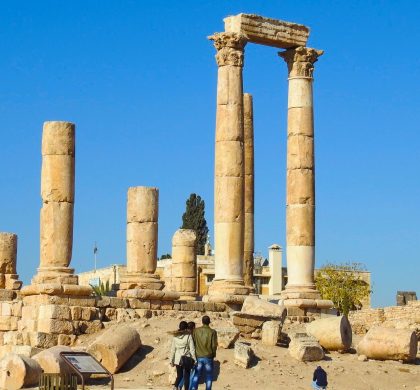
Petra to Amman via the Dead Sea & Kerak Castle – Day 13 to 15 Travel Talk Egypt & Jordan Discovered Tour
23 Jan 2017 - Jordan, Travel Talk Tours Egypt & Jordan Discovered



